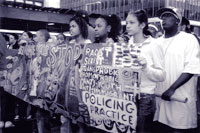New Yorkers march for racial justice
By
Imani Henry
New York
Published Apr 27, 2005 2:47 PM
Over 400 people came out here
April 18 on Racial Justice Day to express their outrage against the infamous
brutality of the New York Police Department.
This 10th Racial Justice Day
was called “the largest protest against police misconduct since Sept. 11,
2001.” The first Racial Justice Day was called by the National Congress
for Puerto Rican Rights in 1993 after the 1991 brutal murder of Manuel Mayi in
the Bronx by a white racist gang.
Due to an inadequate police
investigation and the failure to identify the incident as a bias crime, not one
of Mayi’s assailants has been brought to justice. At the time, one of the
suspected killers was an officer of the New York City Housing
Authority.
This year’s Racial Justice Day was organized as an
emergency response to the April 15 release of former NYPD officer Francis Livoti
from a North Carolina prison after serving time for violating the civil rights
of Anthony Baez. Livoti killed Baez with an illegal and brutal choke-hold in
1994 after Baez’s football accidentally grazed Livoti’s police car
as he played touch football with his brothers near his home.
Livoti was
acquitted during his first trial in 1996. In 1998, he was found guilty of
violating Baez’s civil rights, sentenced to seven years in prison and
fined $12,500.
Traditionally on Racial Justice Day, the surviving family
members are spotlighted. At a rally outside City Hall, the mothers of Timothy
Stansbury, Nicholas Heyward Jr., Manuel Mayi and Anthony Baez represented their
fallen children. City Council member Charles Barron and Bran Fenner from the
Police and State Violence Work ing Group of the Audre Lorde Project also brought
messages of solidarity.
This year’s Racial Justice Day was the
first since the death of key organizer Richie Perez in March 2004. Activist and
partner of Perez, Martha Laureano-Perez, addressed the crowd.
Tearful
parents talked about the support they had received from Perez and his longtime
friend and fellow activist Vicente ‘Panama’ Alba, and credited the
two with giving them tools to fight back against the injustices of the police,
courts and mayor’s office.
The protesters were predominantly people
of color and activists in their twenties or younger. Groups such as FIERCE,
Audre Lorde Project, International Action Center, Committees Against Anti-Asian
Violence, Malcolm X Grassroots Move ment, Justice Committee, Positive Work
Force, El Puente, Desis Rising Up Movement (DRUM), a South Asian organization,
and Sistafire, among many others, organized contingents.
The Baez family
and the Coalition Against Police Brutality have put out a call to the movement
calling for the stepping up of federal investigations into cases of police
violence, and the creation of a truly independent Civilian Complaint Review
Board with subpoena power to monitor and investigate police brutality and
corruption.
CAPB media spokesperson Rickke Mananzula assisted with the
writing of this article.
Articles copyright 1995-2012 Workers World.
Verbatim copying and distribution of this entire article is permitted in any medium without royalty provided this notice is preserved.
Workers World, 55 W. 17 St., NY, NY 10011
Email:
[email protected]
Subscribe
[email protected]
Support independent news
DONATE


